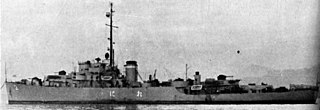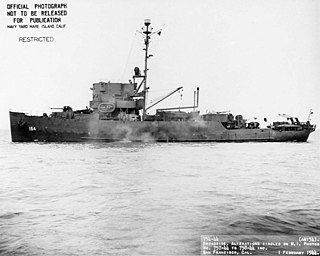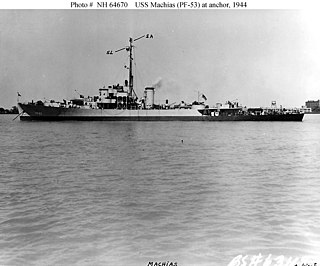
USS Coronado (PG-146/PF-38), a Tacoma-class frigate, was the first ship of the United States Navy named for Coronado, California, a city adjacent to Naval Air Station North Island in San Diego. After World War II service in the U.S. Navy, she served in the Soviet Navy as EK-8 and later in the Japan Maritime Self-Defense Force as Sugi (PF-5) and Sugi (PF-285).

USS Admirable (AM-136) was the lead ship of her class of minesweeper built for the United States Navy during World War II. In commission from 1943 to 1945, she was transferred to the Soviet Navy in 1945 and served as T-331 until stricken in 1958.

USS Allentown (PF-52), a United States Navy Tacoma-class frigate in commission from 1944 to 1945, has thus far been the only U.S. Navy ship to be named for Allentown, Pennsylvania. She later served in the Soviet Navy as EK-9 and in the Japan Maritime Self-Defense Force as JDS Ume (PF-9), JDS Ume (PF-289) and as YAC-14.
USS Evansville (PF-70), a Tacoma-class frigate in commission from 1944 to 1945 and from 1950 to 1953, was the second ship of the United States Navy to be named for Evansville, Indiana. She also served in the Soviet Navy as EK-30 and in the Japan Maritime Self-Defense Force as JDS Keyaki (PF-15), JDS Keyaki (PF-295) and YAC-21.

USS Everett (PG-116/PF-8), a Tacoma-class patrol frigate in commission from 1944 to 1945 and from 1950 to 1953, thus far has been the only ship of the United States Navy to be named for Everett, Washington. She also served in the Soviet Navy as EK-15 and in the Japan Maritime Self-Defense Force as JDS Kiri (PF-11/PF-291/YAC-20).
USS Newport (PF-27), a Tacoma-class frigate in commission from 1944 to 1945, and from 1950 to 1952, was the second ship of the United States Navy to be named for the city of Newport, Rhode Island. She later served in the Soviet Navy as EK-28 and in the Japan Maritime Self-Defense Force as JDS Kaede (PF-13), JDS Kaede (PF-293) and as YAC-17.

USS Rockford (PF-48), a Tacoma-class frigate in commission from 1944 to 1945, thus far has been the only ship of the United States Navy to be named for Rockford, Illinois. She later served in the Soviet Navy as EK-18 and in the Republic of Korea Navy as ROKS Apnokkang (62).
USS Barrier (AM-150) was an Admirable-class minesweeper built for the United States Navy during World War II and in commission from 1944 to 1945. In 1945, she was transferred to the Soviet Union, serving in the Soviet Navy after that as T-335.
USS Bombard (AM-151) was an Admirable-class minesweeper built for the United States Navy during World War II and in commission from 1944 to 1945. In 1945, she was transferred to the Soviet Union, serving after that in the Soviet Navy as T-336.
USS Bond (AM-152) was an Admirable-class minesweeper built for the United States Navy during World War II and in commission from 1943 to 1945. In 1945, she was transferred to the Soviet Union and served after that in the Soviet Navy as T-285 and as BRN-37.
USS Augury (AM-149) was an Admirable-class minesweeper built for the United States Navy during World War II and in commission from 1943 to 1945. In 1945, she was transferred to the Soviet Navy, in which she served as T-334.
USS Astute (AM-148) was an Admirable-class minesweeper built for the United States Navy during World War II and in commission from 1944 to 1945. In 1945, she was transferred to the Soviet Navy, in which she served as T-333.

USS Candid (AM-154) was an Admirable-class minesweeper built for the United States Navy during World War II and in commission from 1943 to 1945. In 1945, she was transferred to the Soviet Union and served after that in the Soviet Navy as T-283.
USS Captivate (AM-156) was an Admirable-class minesweeper built for the United States Navy during World War II and in commission from 1943 to 1945. In 1945, she was transferred to the Soviet Union and then served in the Soviet Navy as T-338.
USS Caravan (AM-157) was an Admirable-class minesweeper built for the United States Navy during World War II and in commission from 1944 to 1945. In 1945, she was transferred to the Soviet Union and after that served in the Soviet Navy as T-337.
USS Caution (AM-158) was an Admirable-class minesweeper built for the United States Navy during World War II and in commission from 1944 to 1945. In 1945, she was transferred to the Soviet Union and after that served in the Soviet Navy as T-284.

USS Disdain (AM-222) was an Admirable-class minesweeper built for the United States Navy during World War II and in commission from 1944 to 1945. She was transferred to the Soviet Union in 1945 and after that served in the Soviet Navy as T-271.
USS Fancy (AM-234) was an Admirable-class minesweeper built for the United States Navy during World War II and in commission from 1944 to 1945. In 1945, she was transferred to the Soviet Union and served in the Soviet Navy after that as T-272 and Vyuga.
USS Mirth (AM-265) was an Admirable-class minesweeper built for the United States Navy during World War II and in commission from 1944 to 1945. In 1945, she was transferred to the Soviet Union and served in the Soviet Navy after that as T-277. The Soviets converted her into a naval trawler in 1948 and renamed her Musson.

The second USS Machias (PF-53) was a United States Navy Tacoma-class frigate in commission from 1944 to 1945 which later served in the Soviet Navy as EK-4 and the Japan Maritime Self-Defense Force as JDS Nara (PF-2), JDS Nara (PF-282) and YTE-8.







